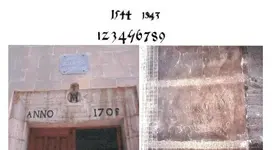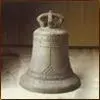Dear elle;
You wrote;
I want to work along side a wonderful group of brains who all share the same enthusiasm in solving a mystery
Perhaps you've inadvertantly wandered into the wong shop, m'lady.

Moving onwards, our mystery bell may contain more clues than the inscriptions might lead one to assume, if we delve a bit deeper into it. Since I've expressed an interest in antique bells, some of my more scholarly contacts have taken it upon themselves to turn me into a bell expert, whether I wish to become one or not. As it is, all standard, off the shelf, run of the mill, ho-hum, plain Jane bells were cast following a strict formula in regards to the alloying and dimensions. This was to help ensure uniform tonality in the bells. This formulii was strictly adhered to by all bell makers throughout Western Europe, with only slight variations existing between the various casters, or founders as they were known.
All standard bells were cast following a 13 to 1 formula, that meaning the thickest part of the bell, called either the brow or the bow, would be 13th of the bell's opening diameter. If one can accurately measure the thickness of the bell at the thickest point, then divide that measurement into the mouth's opening, the sum *should* be 13. If it's anything other than a multiple of 13, the bell in question would have been meant to have been utilized as part of a bell gang, that being multiples bells grouped in a bell tower.
Next, if the alloy composition of the bell could be determined, then this might also assist in determining the bell's intended destination All high quality bells were cast using a alloy formula of 3:1 copper and tin. TO break it down into percentages, copper comprised 78% of the total alloy with tin comprising the other 22%. This particular alloy formula is known as bell metal and it is still in use today by cymbal and musical bell makers.
Higher quality bells were often alloyed with a slight higher concentration of copper, thus making the bell more costly This was said to produce a softer, more melodious tone and special care needed to be taken during the cooling process to ensure the bell would not suffer from internal fractures, thus rendering the bell useless after a short period of use.
Next, if one were able to determine this information with some accuracy, then we could proceed to all possible founders which are known to have cast like examples in the same general region as the birthplace of the bell in question. Further information can be gleaned from the characters on the bell's inscription at this stage and they can be compared to surviving exampples of any one of a number of founding houses. The characters which were cast into a bell using the sand mold technique were not unique to one particular bell, rather were part of the founding house's own particular typeset and the same characters would be used over and over, and thus it is possible to determine a bell's place of origin by comparing the typeset characters, in exactly the same manner that law enforcement is able to determine the make and model of a typewriter which typed a particular letter.
If one were able to gather all of this information with a reasonable amount of accuracy, then it would be a rather simple matter of determining which Jesuit group in Western Europe originally ordered the bell. In the 1600s, all bell founders were guild members, that meaning that they had formed a type of loosely structured union, and they determined price scheduling amongst their members to ensure a fair profit for their labors. Jesuits, like all other Europeans, would have honored a contract with their local bell founder, and if the particular Jesuit group which ordered the bell can be determined, then it becomes a mere matter of contacting the librarian staff of the Jesuit archives in Rome and getting the purchase history of said bell!
As an aside, the Jesuit archivists are a more friendlier and more helpful group than our beloved librarians at the Vatican archives, AVM, and you may find any one of a number of Jesuit scholars at the Jesuit archives willing to assist you. THe Jesuit archives are cataloged by individual communities and if we can discover which community ordered the bell, then getting the rest of the bell'shistory, including it's final destination, would be a walk in the park.
Your friend;
LAMAR








